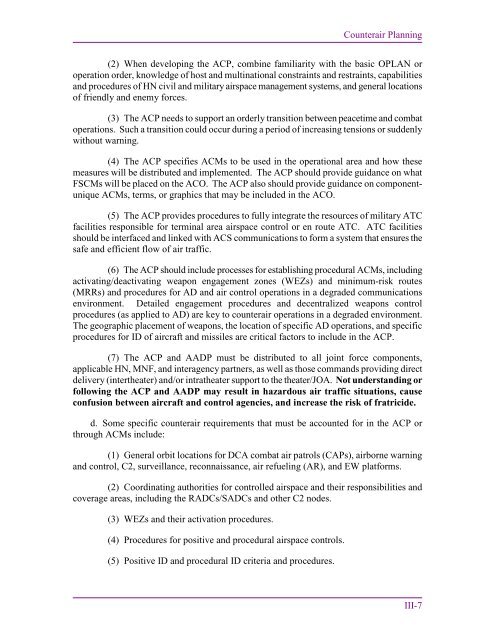JP 3-01 Countering Air and Missile Threats - Defense Innovation ...
JP 3-01 Countering Air and Missile Threats - Defense Innovation ...
JP 3-01 Countering Air and Missile Threats - Defense Innovation ...
You also want an ePaper? Increase the reach of your titles
YUMPU automatically turns print PDFs into web optimized ePapers that Google loves.
Counterair Planning<br />
(2) When developing the ACP, combine familiarity with the basic OPLAN or<br />
operation order, knowledge of host <strong>and</strong> multinational constraints <strong>and</strong> restraints, capabilities<br />
<strong>and</strong> procedures of HN civil <strong>and</strong> military airspace management systems, <strong>and</strong> general locations<br />
of friendly <strong>and</strong> enemy forces.<br />
(3) The ACP needs to support an orderly transition between peacetime <strong>and</strong> combat<br />
operations. Such a transition could occur during a period of increasing tensions or suddenly<br />
without warning.<br />
(4) The ACP specifies ACMs to be used in the operational area <strong>and</strong> how these<br />
measures will be distributed <strong>and</strong> implemented. The ACP should provide guidance on what<br />
FSCMs will be placed on the ACO. The ACP also should provide guidance on componentunique<br />
ACMs, terms, or graphics that may be included in the ACO.<br />
(5) The ACP provides procedures to fully integrate the resources of military ATC<br />
facilities responsible for terminal area airspace control or en route ATC. ATC facilities<br />
should be interfaced <strong>and</strong> linked with ACS communications to form a system that ensures the<br />
safe <strong>and</strong> efficient flow of air traffic.<br />
(6) The ACP should include processes for establishing procedural ACMs, including<br />
activating/deactivating weapon engagement zones (WEZs) <strong>and</strong> minimum-risk routes<br />
(MRRs) <strong>and</strong> procedures for AD <strong>and</strong> air control operations in a degraded communications<br />
environment. Detailed engagement procedures <strong>and</strong> decentralized weapons control<br />
procedures (as applied to AD) are key to counterair operations in a degraded environment.<br />
The geographic placement of weapons, the location of specific AD operations, <strong>and</strong> specific<br />
procedures for ID of aircraft <strong>and</strong> missiles are critical factors to include in the ACP.<br />
(7) The ACP <strong>and</strong> AADP must be distributed to all joint force components,<br />
applicable HN, MNF, <strong>and</strong> interagency partners, as well as those comm<strong>and</strong>s providing direct<br />
delivery (intertheater) <strong>and</strong>/or intratheater support to the theater/JOA. Not underst<strong>and</strong>ing or<br />
following the ACP <strong>and</strong> AADP may result in hazardous air traffic situations, cause<br />
confusion between aircraft <strong>and</strong> control agencies, <strong>and</strong> increase the risk of fratricide.<br />
d. Some specific counterair requirements that must be accounted for in the ACP or<br />
through ACMs include:<br />
(1) General orbit locations for DCA combat air patrols (CAPs), airborne warning<br />
<strong>and</strong> control, C2, surveillance, reconnaissance, air refueling (AR), <strong>and</strong> EW platforms.<br />
(2) Coordinating authorities for controlled airspace <strong>and</strong> their responsibilities <strong>and</strong><br />
coverage areas, including the RADCs/SADCs <strong>and</strong> other C2 nodes.<br />
(3) WEZs <strong>and</strong> their activation procedures.<br />
(4) Procedures for positive <strong>and</strong> procedural airspace controls.<br />
(5) Positive ID <strong>and</strong> procedural ID criteria <strong>and</strong> procedures.<br />
III-7

















